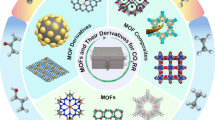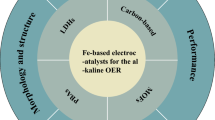Abstract
Development of low-cost, highly efficient catalysts for water splitting is required to replace precious metal catalysts. CeO x -modified CoP@carbon composites are prepared via Ce-doped metal–organic frameworks. The as-prepared CeO x -modified CoP@carbon composites have excellent electrocatalytic activity with respect to the oxygen evolution reaction, for which an overpotential (η) up to ~ 313 mV is achieved at the current density of 10 mA cm−2. In addition, CeO x -modified CoP@carbon composites show an overpotential of up to 127 mV at the current density of 10 mA cm−2 for the hydrogen evolution reaction, showing excellent catalytic activity for water splitting.






Similar content being viewed by others
References
Hunter BM, Blakemore JD, Deimund M, Gray HB, Winkler JR, Muller AM (2014) Highly active mixed-metal nanosheet water oxidation catalysts made by pulsed-laser ablation in liquids. J Am Chem Soc 136:13118–13121
Turner JA (2004) Sustainable hydrogen production. Science 305:972–974
Jiao Y, Zheng Y, Jaroniec M, Qiao SZ (2015) Design of electrocatalysts for oxygen- and hydrogen-involving energy conversion reactions. Chem Soc Rev 44:2060–2086
Zou X, Zhang Y (2015) Noble metal-free hydrogen evolution catalysts for water splitting. Chem Soc Rev 44:5148–5180
Zhu Y-P, Liu Y-P, Ren T-Z, Yuan Z-Y (2015) Self-supported cobalt phosphide mesoporous nanorod arrays: a flexible and bifunctional electrode for highly active electrocatalytic water reduction and oxidation. Adv Funct Mater 25:7337–7347
Morales-Guio CG, Stern LA, Hu X (2014) Nanostructured hydrotreating catalysts for electrochemical hydrogen evolution. Chem Soc Rev 43:6555–6569
Zhao X, Ma X, Sun J, Li D, Yang X (2016) Enhanced catalytic activities of surfactant-assisted exfoliated WS2 nanodots for hydrogen evolution. ACS Nano 10:2159–2166
Chen P, Xu K, Zhou T, Tong Y, Wu J, Cheng H, Lu X, Ding H, Wu C, Xie Y (2016) Strong-coupled cobalt borate nanosheets/graphene hybrid as electrocatalyst for water oxidation under both alkaline and neutral conditions. Angew Chem Int Edit 55:2488–2492
Ambrosi A, Sofer Z, Pumera M (2015) 2H-1T phase transition and hydrogen evolution activity of MoS2, MoSe2, WS2 and WSe2 strongly depends on the MX2 composition. Chem Commun 51:8450–8453
Murthy AP, Theerthagiri J, Madhavan J, Murugan K (2017) Enhancement of hydrogen evolution activities of low-cost transition metal electrocatalysts in near-neutral strongly buffered aerobic media. Electrochem Commun 83:6–10
Tang H, Dou K, Kaun C-C, Kuang Q, Yang S (2014) MoSe2 nanosheets and their graphene hybrids: synthesis, characterization and hydrogen evolution reaction studies. J Mater Chem A 2:360–364
Li F, Zhao X, Mahmood J, Okyay MS, Jung SM, Ahmad I, Kim SJ, Han GF, Park N, Baek JB (2017) Macroporous Inverse Opal-like MoxC with incorporated Mo vacancies for significantly enhanced hydrogen evolution. ACS Nano 11:7527–7533
Zhu YP, Ma TY, Jaroniec M, Qiao SZ (2017) Self-templating synthesis of hollow Co3O4 microtube arrays for highly efficient water electrolysis. Angew Chem 56:1324–1328
Gong M, Zhou W, Tsai MC, Zhou J, Guan M, Lin MC, Zhang B, Hu Y, Wang DY, Yang J, Pennycook SJ, Hwang BJ, Dai H (2014) Nanoscale nickel oxide/nickel heterostructures for active hydrogen evolution electrocatalysis. Nat Commun 5:4695
Lin Y, Li Y, Lan Q, Lv X-J, Liu S, Liu D, Hu W (2018) A novel strategy for preparing layered double hydroxide/exfoliated carbon nanostructures composites as superior electrochemical catalysts with respect to oxygen evolution and methanol oxidation. J Alloys Compd 744:347–356
Chen WF, Sasaki K, Ma C, Frenkel AI, Marinkovic N, Muckerman JT, Zhu Y, Adzic RR (2012) Hydrogen-evolution catalysts based on non-noble metal nickel-molybdenum nitride nanosheets. Angew Chem 51:6131–6135
Zhang X, An L, Yin J, Xi P, Zheng Z, Du Y (2017) Effective construction of high-quality iron Oxy-hydroxides and Co-doped iron Oxy-hydroxides nanostructures: towards the promising oxygen evolution reaction application. Sci Rep 7:43590
Xu Y, Wu R, Zhang J, Shi Y, Zhang B (2013) Anion-exchange synthesis of nanoporous FeP nanosheets as electrocatalysts for hydrogen evolution reaction. Chem Commun (Camb) 49:6656–6658
Ya G, Zhongling L, Feiyang Y, Huaqiao T, Gang Y, Yonghui W, Yuanyuan M, Yangguang L (2018) A Co2P/WC nano-heterojunction covered with N-doped carbon as highly efficient electrocatalyst for hydrogen evolution reaction. Chemsuschem 11:1082–1091
Wang P, Zhan S, Wang H, Xia Y, Hou Q, Zhou Q, Li Y, Kumar RR (2018) Cobalt phosphide nanowires as efficient co-catalyst for photocatalytic hydrogen evolution over Zn0.5Cd0.5S. Appl Catal B: Environ 230:210–219
Xu X, Cao R, Jeong S, Cho J (2012) Spindle-like mesoporous α-Fe2O3 anode material prepared from MOF template for high-rate lithium batteries. Nano Lett 12:4988–4991
Zhao S, Yin H, Du L, He L, Zhao K, Chang L, Yin G, Zhao H, Liu S, Tang Z (2014) Carbonized nanoscale metal-organic frameworks as high performance electrocatalyst for oxygen reduction reaction. ACS Nano 8:12660–12668
Chaikittisilp W, Hu M, Wang H, Huang H-S, Fujita T, Wu KCW, Chen L-C, Yamauchi Y, Ariga K (2012) Nanoporous carbons through direct carbonization of a zeolitic imidazolate framework for supercapacitor electrodes. Chem Commun 48:7259–7261
Li SP, Zhang G, Tu XM, Li JH (2018) Polycrystalline CoP/CoP2 Structures for Efficient Full Water Splitting. Chemelectrochem 5:701–707
Wu C, Yang YJ, Dong D, Zhang YH, Li JH (2017) In situ coupling of CoP polyhedrons and carbon nanotubes as highly efficient hydrogen evolution reaction electrocatalyst. Small 13:1602873
Zhang G, Wang GC, Liu Y, Liu HJ, Qu JH, Li JH (2016) Highly active and stable catalysts of phytic acid-derivative transition metal phosphides for full water splitting. J Am Chem Soc 138:14686–14693
Liu MJ, Li JH (2017) Self-supported ferric phosphide spherical clusters as efficient electrocatalysts for hydrogen evolution reaction. Chem Select 2:9472–9478
James SL (2003) Metal-organic frameworks. Chem Soc Rev 32:276–288
Liu X, Dong J, You B, Sun Y (2016) Competent overall water-splitting electrocatalysts derived from ZIF-67 grown on carbon cloth. RSC Adv 6:73336–73342
Jiao L, Zhou Y-X, Jiang H-L (2016) Metal–organic framework-based CoP/reduced graphene oxide: high-performance bifunctional electrocatalyst for overall water splitting. Chem Sci 7:1690–1695
You B, Jiang N, Sheng M, Gul S, Yano J, Sun Y (2015) High-performance overall water splitting electrocatalysts derived from cobalt-based metal-organic frameworks. Chem Mater 27:7636–7642
Paier J, Penschke C, Sauer J (2013) Oxygen defects and surface chemistry of ceria: quantum chemical studies compared to experiment. Chem Rev 113:3949–3985
Feng J-X, Ye S-H, Xu H, Tong Y-X, Li G-R (2016) Design and synthesis of FeOOH/CeO2 heterolayered nanotube electrocatalysts for the oxygen evolution reaction. Adv Mater 28:4698–4703
Zheng YR, Gao MR, Gao Q, Li HH, Xu J, Wu ZY, Yu SH (2015) An efficient CeO2/CoSe2 nanobelt composite for electrochemical water oxidation. Small 11:182–188
Marrocchelli D, Yildiz B (2012) First-principles assessment of H2S and H2O reaction mechanisms and the subsequent hydrogen absorption on the CeO2(111) surface. J Phys Chem C 116:2411–2424
Wu A, Xie Y, Ma H, Tian C, Gu Y, Yan H, Zhang X, Yang G, Fu H (2018) Integrating the active OER and HER components as the heterostructures for the efficient overall water splitting. Nano Energy 44:353–363
Yin P, Yao T, Wu Y, Zheng L, Lin Y, Liu W, Ju H, Zhu J, Hong X, Deng Z, Zhou G, Wei S, Li Y (2016) Single cobalt atoms with precise N-coordination as superior oxygen reduction reaction catalysts. Angew Chem Int Ed 55:10800–10805
Fan K, Chen H, Ji Y, Huang H, Claesson PM, Daniel Q, Philippe B, Rensmo H, Li F, Luo Y, Sun L (2016) Nickel–vanadium monolayer double hydroxide for efficient electrochemical water oxidation. Nat Commun 7:11981
Yang F, Chen Y, Cheng G, Chen S, Luo W (2017) Ultrathin nitrogen-doped carbon coated with CoP for efficient hydrogen evolution. ACS Catal 7:3824–3831
Xu M, Han L, Han Y, Yu Y, Zhai J, Dong S (2015) Porous CoP concave polyhedron electrocatalysts synthesized from metal–organic frameworks with enhanced electrochemical properties for hydrogen evolution. J Mater Chem A 3:21471–21477
Lin Z, Waller G, Liu Y, Liu M, Wong C-P (2012) Facile synthesis of nitrogen-doped graphene via pyrolysis of graphene oxide and urea, and its electrocatalytic activity toward the oxygen-reduction reaction. Adv Energy Mater 2:884–888
Wu Z, Li M, Howe J, Meyer HM, Overbury SH (2010) Probing defect sites on CeO2 nanocrystals with well-defined surface planes by Raman spectroscopy and O2 adsorption. Langmuir 26:16595–16606
Varghese B, Teo CH, Zhu Y, Reddy MV, Chowdari BVR, Wee ATS, Tan VBC, Lim CT, Sow C-H (2007) Co3O4 nanostructures with different morphologies and their field-emission properties. Adv Funct Mater 17:1932–1939
Uy D, O’Neill AE, Xu L, Weber WH, McCabe RW (2003) Observation of cerium phosphate in aged automotive catalysts using Raman spectroscopy. Appl Catal B 41:269–278
Wang H, Min S, Wang Q, Li D, Casillas G, Ma C, Li Y, Liu Z, Li LJ, Yuan J, Antonietti M, Wu T (2017) Nitrogen-doped nanoporous carbon membranes with Co/CoP Janus-type nanocrystals as hydrogen evolution electrode in both acidic and alkaline environments. ACS Nano 11:4358–4364
Tabassum H, Guo W, Meng W, Mahmood A, Zhao R, Wang Q, Zou R (2017) Metal-organic frameworks derived cobalt phosphide architecture encapsulated into B/N Co-doped graphene nanotubes for all pH value electrochemical hydrogen evolution. Adv Energy Mater 7:1601671
Liu M, Li J (2016) Cobalt phosphide hollow polyhedron as efficient bifunctional electrocatalysts for the evolution reaction of hydrogen and oxygen. ACS Appl Mater Interfaces 8:2158–2165
Xiong D, Wang X, Li W, Liu L (2016) Facile synthesis of iron phosphide nanorods for efficient and durable electrochemical oxygen evolution. Chem Commun 52:8711–8714
Li Z, Dou X, Zhao Y, Wu C (2016) Enhanced oxygen evolution reaction of metallic nickel phosphide nanosheets by surface modification. Inorg Chem Front 3:1021–1027
Acknowledgement
This work was financially supported by Natural Science Foundation of Hebei province (Grant No. E2014203033). We also acknowledge the financial support of the open foundation of Key Laboratory of Advanced Energy Materials Chemistry (Ministry of Education) (111 Project, B12015).
Author information
Authors and Affiliations
Corresponding author
Rights and permissions
About this article
Cite this article
Lan, Q., Lin, Y., Li, Y. et al. MOF-derived, CeO x -modified CoP/carbon composites for oxygen evolution and hydrogen evolution reactions. J Mater Sci 53, 12123–12131 (2018). https://doi.org/10.1007/s10853-018-2519-6
Received:
Accepted:
Published:
Issue Date:
DOI: https://doi.org/10.1007/s10853-018-2519-6




